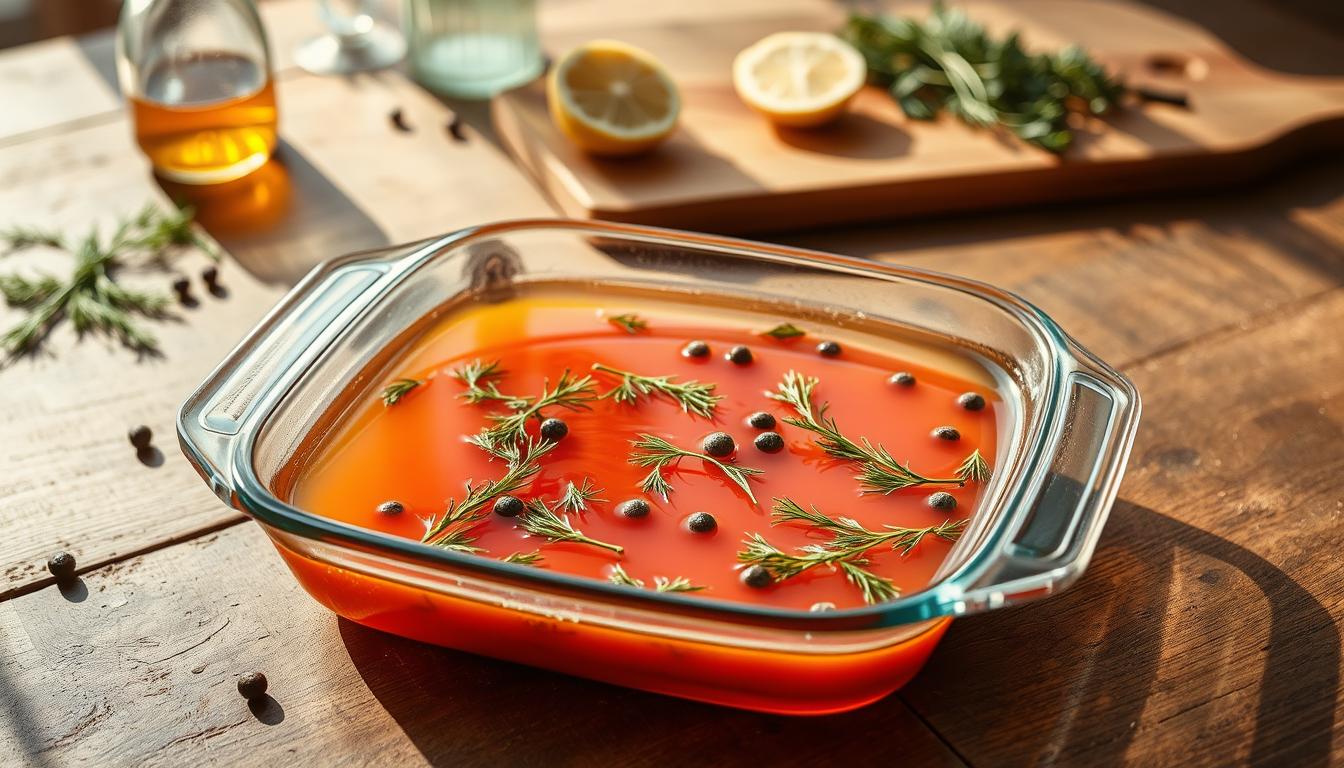The first time I tasted perfectly smoked salmon, it was like discovering a culinary secret. It turned an ordinary fish into an extraordinary delicacy. My journey into mastering the smoked salmon brine recipe started with a passion for creating restaurant-quality seafood at home.
Salmon is a favorite among American seafood lovers, and for good reason. With the right smoked salmon brine recipe, you can make this popular fish into a mouthwatering masterpiece. It will amaze even the most particular food lovers.
Learning how to make smoked salmon brine is more than just a cooking technique—it’s an art form. It unlocks deep, rich flavors and turns a simple piece of fish into a gourmet experience. Whether you’re a home cook or a culinary adventurer, this guide will help you create a smoked salmon brine that brings out the best in your fish.
From selecting the perfect salmon to understanding the intricate process of brining, you’ll learn how to turn an ordinary meal into an extraordinary culinary adventure. Get ready to unlock the secrets of creating restaurant-quality smoked salmon. It will have everyone asking for your recipe.
Table of Contents
What is Smoked Salmon Brine recipe?
Making the best smoked salmon brine is an art. It turns simple fish into a dish fit for a feast. Brining adds flavor and keeps the fish moist while smoking.
A smoked salmon brine is a mix of special ingredients. They work together to boost the fish’s taste. This mix is the base for a delicious smoking experience.
Understanding the Basics of Brining
Brining is not just about soaking fish in saltwater. It’s a science that keeps proteins moist and flavorful. Brining salmon does several key things:
- Tenderizes the fish’s texture
- Enhances natural flavors
- Prevents moisture loss during smoking
- Creates a layer for smoke to stick to the fish
Key Ingredients in Smoked Salmon Brine
A classic smoked salmon brine has:
- Water: The main liquid
- Salt: Crucial for keeping it fresh and tasty
- Sugar: Helps balance salt and promotes browning
- Optional flavor boosters like:
- Black pepper
- Garlic powder
- Dried herbs
- Citrus zest
Knowing the science of brining opens the door to making top-notch smoked salmon at home. The trick is to find the right balance of ingredients. And make sure your salmon soaks up those amazing flavors well.
The Importance of Brining for Salmon
Turning your salmon into something special starts with a homemade smoked salmon brine. Brining boosts the flavor, texture, and quality of your fish. It’s a key step to making smoked salmon at home taste like it’s from a restaurant.
Preparing an easy smoked salmon brine recipe does more than just add flavor. The brining process works magic that improves your salmon in several ways:
- Locks in moisture, preventing dry and tough meat
- Enhances natural flavor profiles
- Creates a more tender and succulent texture
- Helps protect the fish during smoking process
Why Brining Enhances Flavor
Salt is the key ingredient in your homemade smoked salmon brine recipe. It goes deep into the salmon’s cells, breaking down proteins. This lets seasonings spread evenly, making every bite perfectly seasoned.
Benefits Beyond Taste
Brining does more than just taste better. It helps keep your fish juicy by reducing moisture loss during smoking. For hot-smoked salmon, cooked between 120-175°F, brining is even more important for texture and flavor.
By learning this simple technique, you can turn your homemade salmon into a gourmet treat. It will taste as good as what you find in professional smokehouses.
Essential Ingredients for Your Brine
To make the perfect smoked salmon brine, you need to pick the right ingredients. Knowing the best smoked salmon brine ingredients and the right ratios is key. It turns a simple fish into a dish to remember.
Salt: The Cornerstone of Flavor
Kosher salt is the base of any salmon brine. Use ⅓ cup of kosher salt for every quart of water in wet brines. For dry brines, about ½ cup of salt is needed.
- Kosher salt provides essential preservation
- Helps draw moisture from the salmon
- Enhances overall flavor profile
Sweeteners: Balancing the Flavor
Brown sugar is vital in your brine mix. Aim for a 3:1 ratio of brown sugar to kosher salt in dry brines. This mix gives a sweet-savory taste that matches the salmon’s richness.
Flavor Enhancers: Herbs and Spices
Add depth to your brine with herbs and spices. Here are some great options:
- Fresh cracked black peppercorns
- Bay leaves
- Garlic cloves
- Fresh dill
- Lemon zest
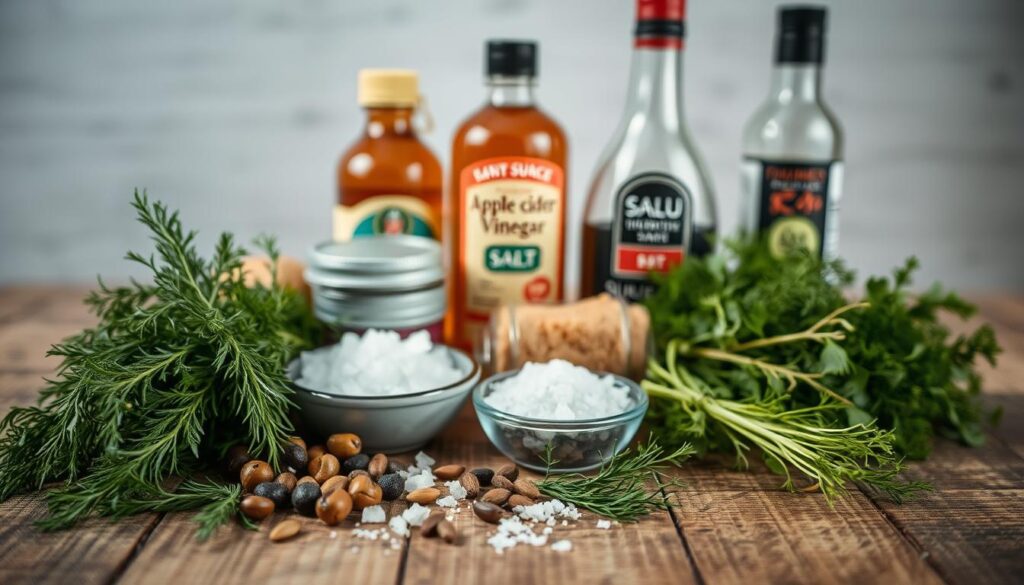
| Ingredient | Wet Brine Ratio | Dry Brine Ratio |
|---|---|---|
| Kosher Salt | ⅓ cup per quart | ½ cup |
| Brown Sugar | 1 cup per quart | 1 cup |
| Recommended Brining Time | 12-24 hours | Up to 12 hours |
Pro tip: Try different herbs to make your own unique smoked salmon brine. The goal is to boost the salmon’s flavor without overpowering it.
Step-by-Step Guide to Making the Brine
Making smoked salmon brine is an art that turns simple fish into a culinary gem. It’s perfect for both home cooks and smoking fans. Learning how to make smoked salmon brine will boost your cooking and wow your guests.
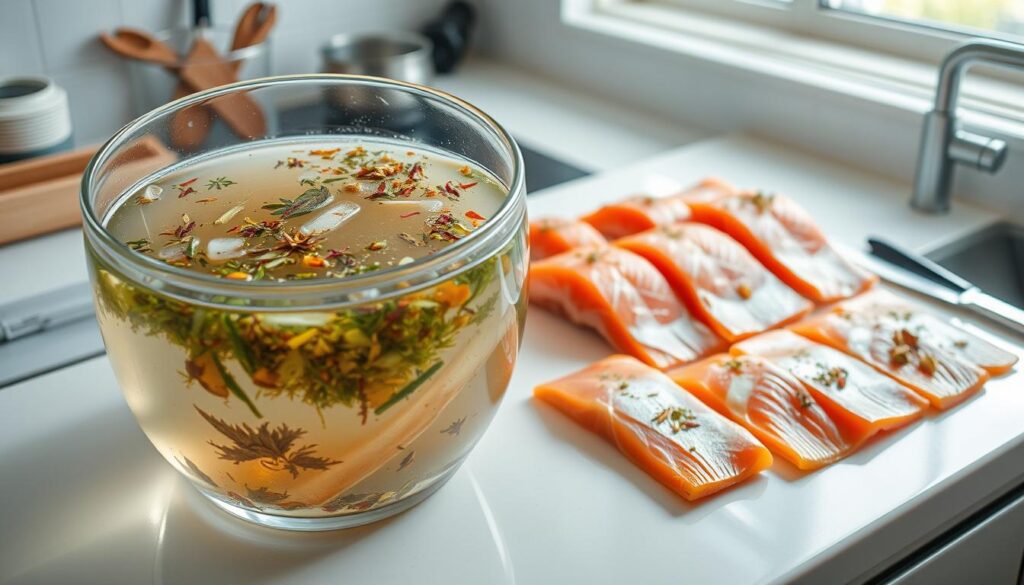
Your smoked salmon brine recipe needs precision and care. We’ll guide you through easy steps for delicious results.
Measuring Your Ingredients Precisely
Getting your measurements right is key for your smoked salmon brine. Here’s what you’ll need:
- 1/2 cup sea salt or kosher salt
- 1/4 cup sugar
- 1 tablespoon freshly ground black pepper
- 2 tablespoons fresh or dried dill
- 1 teaspoon liquid smoke (optional)
Mixing the Ingredients Properly
Start by mixing your dry ingredients in a big bowl. Whisk them well to spread evenly. Then, mix your liquid ingredients separately to blend smoothly with the dry ones.
| Ingredient | Quantity | Purpose |
|---|---|---|
| Sea Salt | 1/2 cup | Flavor enhancement and preservation |
| Sugar | 1/4 cup | Balance saltiness and create caramelization |
| Black Pepper | 1 tablespoon | Add spicy undertone |
Cooling the Brine Before Use
Let the brine cool down completely after mixing. This stops it from cooking the salmon too early. Chill the brine for at least 30 minutes before using it.
Pro tip: Always pick fresh, top-notch salmon for the best taste. Your effort in making the brine will pay off with amazing smoked salmon in your kitchen.
How Long to Brine Salmon
Getting the brine time right is key to making great smoked salmon. The right brining time can turn a simple fish into a dish to remember.
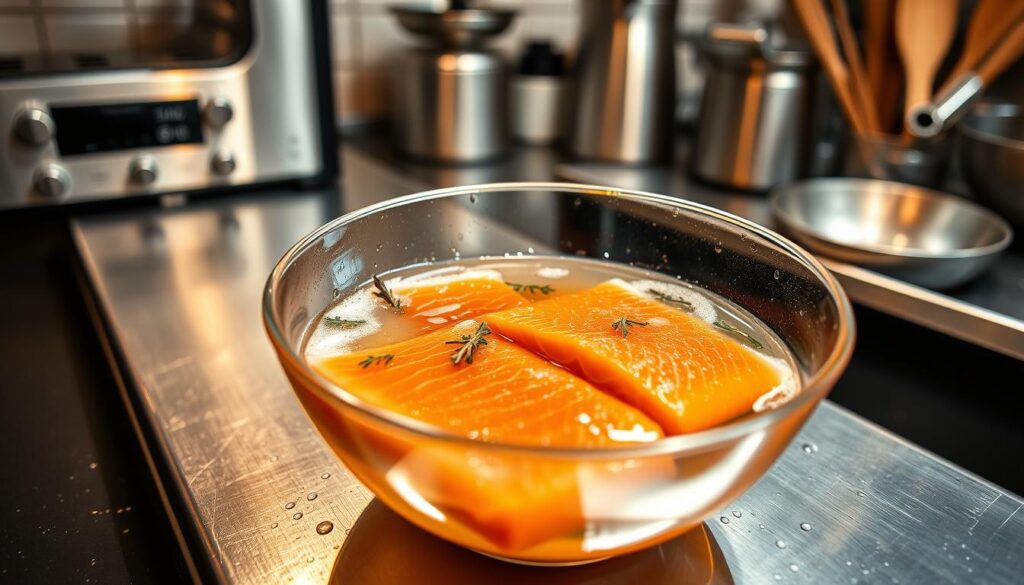
Timing is everything in the best smoked salmon brine. Most people find that brining salmon takes 5-8 hours. This depends on a few important things.
Key Factors Influencing Brining Duration
- Salmon thickness: Thicker fillets need longer brining times
- Desired salt intensity: Longer brines mean stronger flavors
- Fillet weight: Heavier fish need more brining
- Personal taste preferences
Recommended Brining Times
Brining time can change based on different conditions. Here are some general tips:
- Thin fillets (under 1 inch): 3-4 hours
- Medium fillets (1-2 inches): 5-6 hours
- Thick fillets (over 2 inches): 8-12 hours
Pro tip: Don’t brine salmon for more than 12 hours. It can get too salty and lose its texture. Always rinse the salmon well after brining to get rid of extra salt.
Pro Recommendations
For the best smoked salmon brine, aim for 5 hours of brining. This time is perfect for flavor and texture. It keeps your salmon moist and well-seasoned.
Different Brining Techniques
Mastering the art of a perfect smoked salmon brine recipe requires understanding different brining techniques. Whether you’re a home cook or a passionate seafood enthusiast, knowing when to use wet or dry brining can elevate your salmon smoking game.
An easy smoked salmon brine recipe starts with choosing the right technique. Each method offers unique advantages for preparing your fish before smoking.
Wet Brining: Submerging for Flavor
Wet brining involves completely submerging salmon in a liquid salt solution. This method helps:
- Enhance moisture retention
- Distribute seasonings evenly
- Create a more uniform flavor profile
Dry Brining: Surface Treatment Technique
Dry brining applies a direct salt and sugar mixture to the salmon’s surface. This approach offers:
- Concentrated flavor absorption
- Easier preparation
- Less liquid handling
| Brining Method | Time Required | Best Used For |
|---|---|---|
| Wet Brining | 1-2 hours | Larger salmon fillets |
| Dry Brining | 4-6 hours | Smaller or thinner cuts |
Your choice between wet and dry brining depends on your specific salmon cut, time availability, and flavor preferences. Experiment with both techniques to discover your perfect smoked salmon brine recipe.
Tips for Choosing Salmon for Brining
Choosing the right salmon is key to making the best homemade smoked salmon brine. The quality of your fish affects the taste and texture of your smoked salmon. Knowing how to pick salmon can make your smoking experience much better.
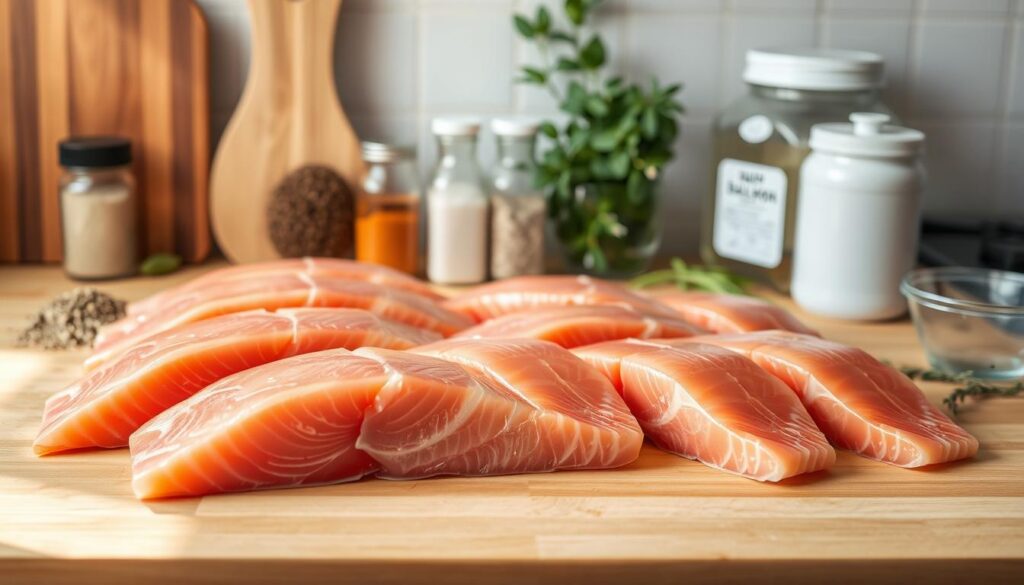
Types of Salmon Ideal for Smoking
Not all salmon is good for smoking. Some types are better than others:
- King (Chinook) Salmon: It has a lot of oil, making it great for both hot and cold smoking
- Sockeye Salmon: It has a firm texture and strong flavor, perfect for hot smoking
- Coho Salmon: It has a balanced taste with medium oil content
- Chum Salmon: It’s cheaper and has a milder taste
Fresh vs. Frozen: What to Look For
Your fish choice is important when making the best smoked salmon brine. Fresh salmon is best, but good frozen salmon can also work well. Here’s what to look for:
- Fresh salmon should smell like the ocean
- The flesh should feel firm and bounce back when touched
- Color should be bright and even
- For frozen salmon, make sure it’s vacuum-sealed
- Thaw frozen salmon slowly in the fridge to keep it good
Pro tip: King Salmon is great because it’s full of omega-3s and tastes amazing. When picking salmon, choose quality and freshness to get the best results with your homemade smoked salmon brine.
Common Mistakes to Avoid
Getting your smoked salmon brine just right takes focus and knowing what to watch out for. It’s not just about following a recipe. It’s about avoiding mistakes that can ruin your dish.
When you’re making your smoked salmon brine, there are a few common mistakes to steer clear of. Knowing these can help you make delicious smoked salmon at home, just like in a restaurant.
Over-Brining: Recognizing the Warning Signs
Over-brining can turn your salmon into something too salty and mushy. Look out for these signs:
- Excessively firm texture
- Extremely salty taste
- Translucent, almost rubbery appearance
- Loss of natural salmon flavor
Ingredient Selection Mistakes
The ingredients you choose greatly affect your smoked salmon’s taste. Here are some few mistakes you should avoid:
| Mistake | Correct Approach |
|---|---|
| Using table salt | Use kosher salt for even distribution |
| Skipping sugar | Add brown sugar for balanced flavor |
| Using harsh spices | Choose mild, complementary seasonings |
By knowing these common mistakes, you’ll be ready to make perfectly brined and smoked salmon. Remember, the more you practice, the better you’ll get at preparing salmon.
Final Steps: Smoking Your Salmon
When you’re making smoked salmon, picking the right wood chips and keeping the temperature just right are key. King Salmon is perfect for smoking because it’s so oily. The brine ingredients and ratios you use will really affect the taste.
Choosing the right wood chips is important for flavor. Alder, apple, and cherry woods add unique tastes that go well with salmon. Make sure to soak your wood chips for at least 30 minutes before smoking. This helps keep the smoke steady. Smoke your salmon at a temperature between 160°F and 180°F. This keeps the salmon tender and adds a deep smoky flavor.
Smoke your salmon for 2 to 4 hours until it reaches 145°F. This ensures it’s safe to eat. Once it’s done, you can keep it in the fridge for up to two weeks. A tip: Vacuum-sealing can make it last a month. Enjoy it with a crisp Sauvignon Blanc or light Pinot Noir for a great meal.
Storing your salmon properly is important to keep it fresh. Always keep it in the fridge and use clean tools when handling. With a bit of practice, you can make delicious smoked salmon at home, just like a restaurant.

